sensor Seat Altea 2014 User Guide
[x] Cancel search | Manufacturer: SEAT, Model Year: 2014, Model line: Altea, Model: Seat Altea 2014Pages: 321, PDF Size: 4.52 MB
Page 134 of 321
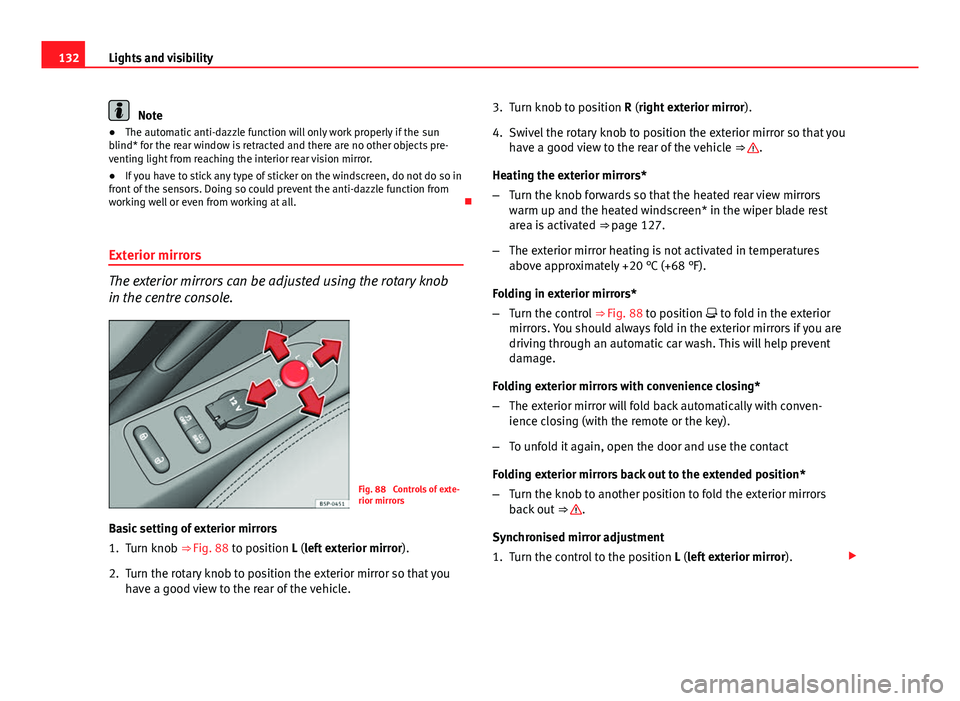
132Lights and visibility
Note
● The automatic anti-dazzle function will only work properly if the sun
blind* for the rear window is retracted and there are no other objects pre-
venting light from reaching the interior rear vision mirror.
● If you have to stick any type of sticker on the windscreen, do not do so in
front of the sensors. Doing so could prevent the anti-dazzle function from
working well or even from working at all.
Exterior mirrors
The exterior mirrors can be adjusted using the rotary knob
in the centre console.
Fig. 88 Controls of exte-
rior mirrors
Basic setting of exterior mirrors
1. Turn knob ⇒
Fig. 88 to position L (left exterior mirror ).
2. Turn the rotary knob to position the exterior mirror so that you have a good view to the rear of the vehicle. 3. Turn knob to position R (right exterior mirror
).
4. Swivel the rotary knob to position the exterior mirror so that you have a good view to the rear of the vehicle ⇒
.
Heating the exterior mirrors*
– Turn the knob forwards so that the heated rear view mirrors
warm up and the heated windscreen* in the wiper blade rest
area is activated ⇒ page 127.
– The exterior mirror heating is not activated in temperatures
above approximately +20 °C (+68 °F).
Folding in exterior mirrors*
– Turn the control ⇒ Fig. 88 to position to fold in the exterior
mirrors. You should always fold in the exterior mirrors if you are
driving through an automatic car wash. This will help prevent
damage.
Folding exterior mirrors with convenience closing*
– The exterior mirror will fold back automatically with conven-
ience closing (with the remote or the key).
– To unfold it again, open the door and use the contact
Folding exterior mirrors back out to the extended position*
– Turn the knob to another position to fold the exterior mirrors
back out ⇒
.
Synchronised mirror adjustment
1. Turn the control to the position L (left exterior mirror).
Page 192 of 321
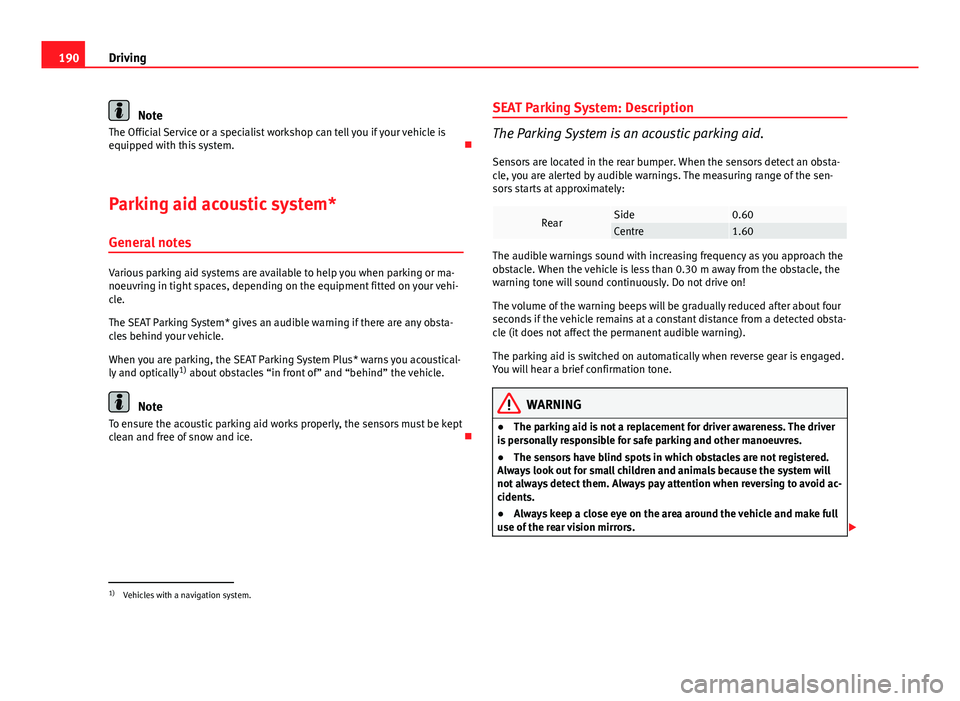
190Driving
Note
The Official Service or a specialist workshop can tell you if your vehicle is
equipped with this system.
Parking aid acoustic system*
General notes
Various parking aid systems are available to help you when parking or ma-
noeuvring in tight spaces, depending on the equipment fitted on your vehi-
cle.
The SEAT Parking System* gives an audible warning if there are any obsta-
cles behind your vehicle.
When you are parking, the SEAT Parking System Plus* warns you acoustical-
ly and optically 1)
about obstacles “in front of” and “behind” the vehicle.
Note
To ensure the acoustic parking aid works properly, the sensors must be kept
clean and free of snow and ice. SEAT Parking System: Description
The Parking System is an acoustic parking aid.
Sensors are located in the rear bumper. When the sensors detect an obsta-
cle, you are alerted by audible warnings. The measuring range of the sen-
sors starts at approximately:
RearSide0.60Centre1.60
The audible warnings sound with increasing frequency as you approach the
obstacle. When the vehicle is less than 0.30 m away from the obstacle, the
warning tone will sound continuously. Do not drive on!
The volume of the warning beeps will be gradually reduced after about four
seconds if the vehicle remains at a constant distance from a detected obsta-
cle (it does not affect the permanent audible warning).
The parking aid is switched on automatically when reverse gear is engaged.
You will hear a brief confirmation tone.
WARNING
● The parking aid is not a replacement for driver awareness. The driver
is personally responsible for safe parking and other manoeuvres.
● The sensors have blind spots in which obstacles are not registered.
Always look out for small children and animals because the system will
not always detect them. Always pay attention when reversing to avoid ac-
cidents.
● Always keep a close eye on the area around the vehicle and make full
use of the rear vision mirrors.
1)
Vehicles with a navigation system.
Page 193 of 321
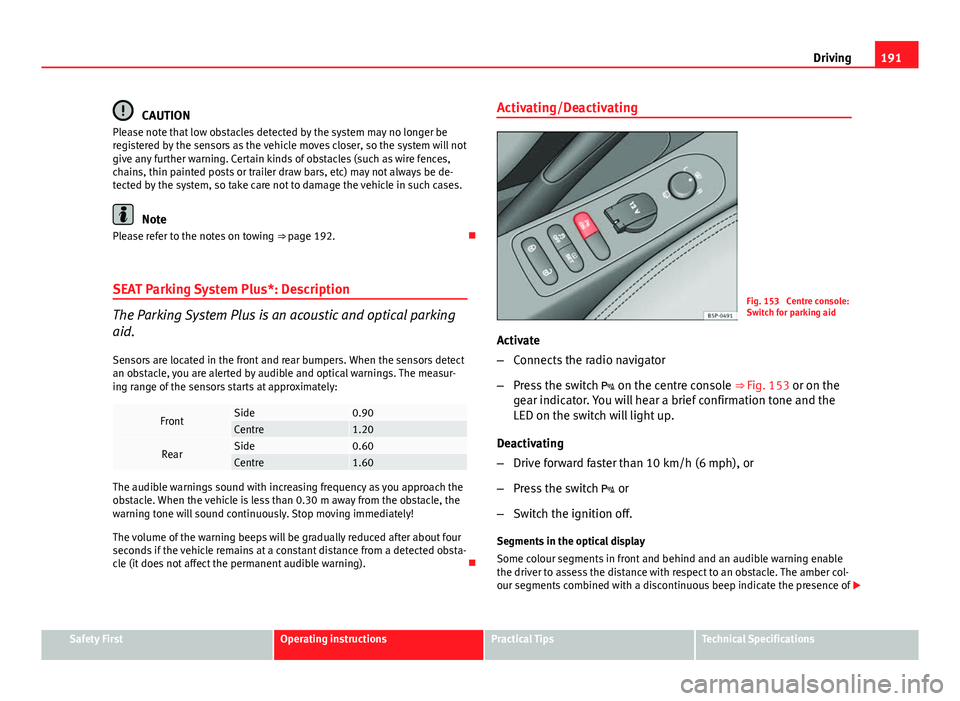
191
Driving
CAUTION
Please note that low obstacles detected by the system may no longer be
registered by the sensors as the vehicle moves closer, so the system will not
give any further warning. Certain kinds of obstacles (such as wire fences,
chains, thin painted posts or trailer draw bars, etc) may not always be de-
tected by the system, so take care not to damage the vehicle in such cases.
Note
Please refer to the notes on towing ⇒ page 192.
SEAT Parking System Plus*: Description
The Parking System Plus is an acoustic and optical parking
aid.
Sensors are located in the front and rear bumpers. When the sensors detect
an obstacle, you are alerted by audible and optical warnings. The measur-
ing range of the sensors starts at approximately:
FrontSide0.90Centre1.20
RearSide0.60Centre1.60
The audible warnings sound with increasing frequency as you approach the
obstacle. When the vehicle is less than 0.30 m away from the obstacle, the
warning tone will sound continuously. Stop moving immediately!
The volume of the warning beeps will be gradually reduced after about four
seconds if the vehicle remains at a constant distance from a detected obsta-
cle (it does not affect the permanent audible warning). Activating/Deactivating
Fig. 153 Centre console:
Switch for parking aid
Activate
– Connects the radio navigator
– Press the switch on the centre console ⇒ Fig. 153 or on the
gear indicator. You will hear a brief confirmation tone and the
LED on the switch will light up.
Deactivating
– Drive forward faster than 10 km/h (6 mph), or
– Press the switch or
– Switch the ignition off.
Segments in the optical display
Some colour segments in front and behind and an audible warning enable
the driver to assess the distance with respect to an obstacle. The amber col-
our segments combined with a discontinuous beep indicate the presence of
Safety FirstOperating instructionsPractical TipsTechnical Specifications
Page 194 of 321
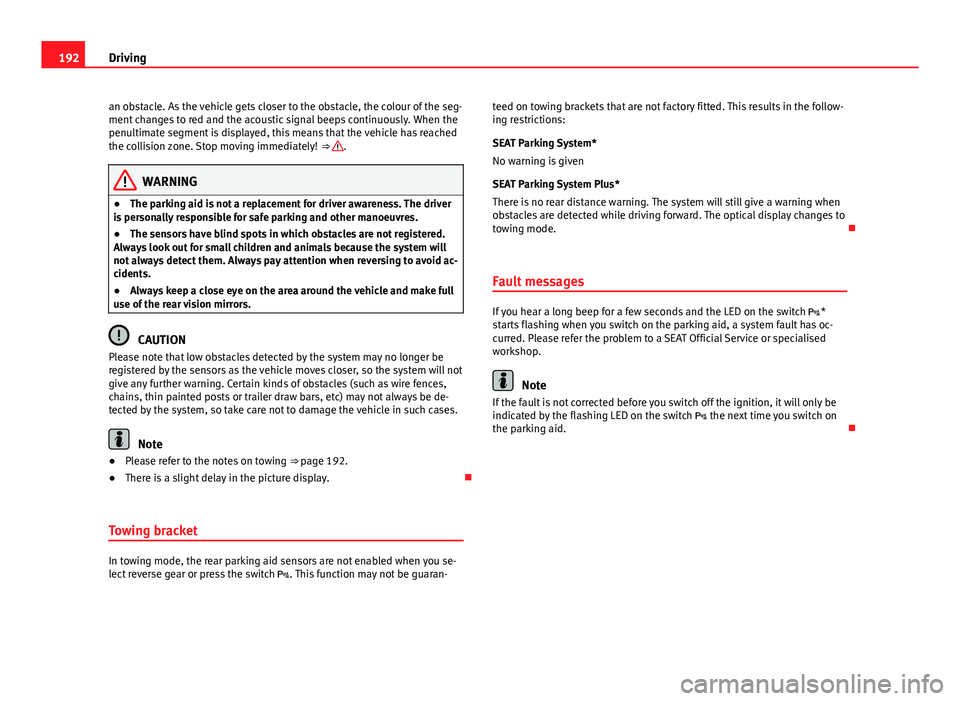
192Driving
an obstacle. As the vehicle gets closer to the obstacle, the colour of the seg-
ment changes to red and the acoustic signal beeps continuously. When the
penultimate segment is displayed, this means that the vehicle has reached
the collision zone. Stop moving immediately! ⇒
.
WARNING
● The parking aid is not a replacement for driver awareness. The driver
is personally responsible for safe parking and other manoeuvres.
● The sensors have blind spots in which obstacles are not registered.
Always look out for small children and animals because the system will
not always detect them. Always pay attention when reversing to avoid ac-
cidents.
● Always keep a close eye on the area around the vehicle and make full
use of the rear vision mirrors.
CAUTION
Please note that low obstacles detected by the system may no longer be
registered by the sensors as the vehicle moves closer, so the system will not
give any further warning. Certain kinds of obstacles (such as wire fences,
chains, thin painted posts or trailer draw bars, etc) may not always be de-
tected by the system, so take care not to damage the vehicle in such cases.
Note
● Please refer to the notes on towing ⇒ page 192.
● There is a slight delay in the picture display.
Towing bracket
In towing mode, the rear parking aid sensors are not enabled when you se-
lect reverse gear or press the switch . This function may not be guaran- teed on towing brackets that are not factory fitted. This results in the follow-
ing restrictions:
SEAT Parking System*
No warning is given
SEAT Parking System Plus*
There is no rear distance warning. The system will still give a warning when
obstacles are detected while driving forward. The optical display changes to
towing mode.
Fault messages
If you hear a long beep for a few seconds and the LED on the switch *
starts flashing when you switch on the parking aid, a system fault has oc-
curred. Please refer the problem to a SEAT Official Service or specialised
workshop.
Note
If the fault is not corrected before you switch off the ignition, it will only be
indicated by the flashing LED on the switch the next time you switch on
the parking aid.
Page 200 of 321
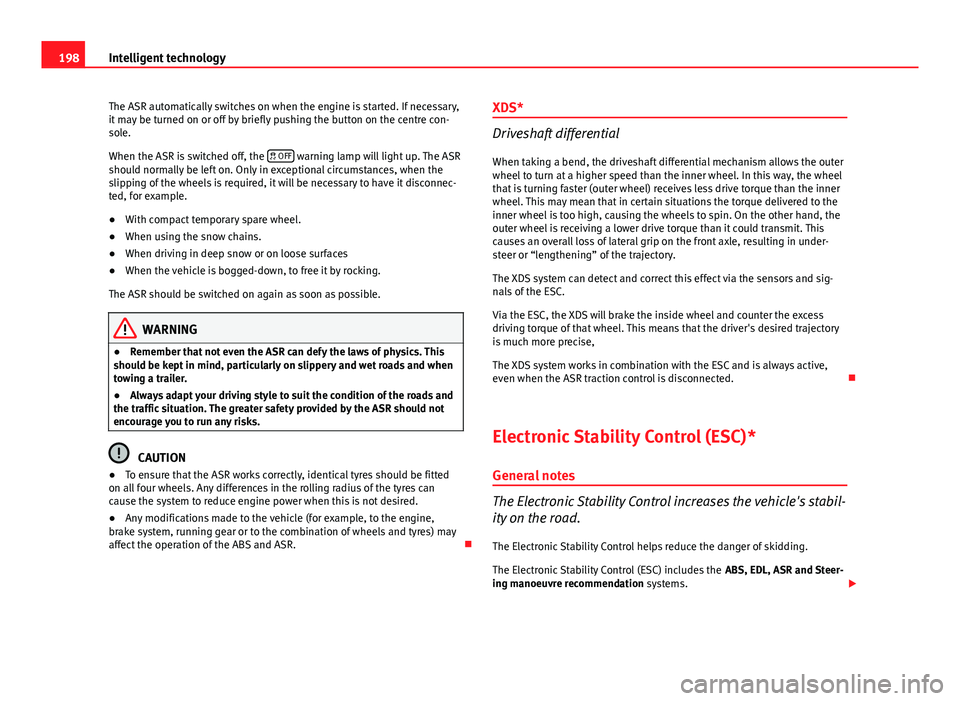
198Intelligent technology
The ASR automatically switches on when the engine is started. If necessary,
it may be turned on or off by briefly pushing the button on the centre con-
sole.
When the ASR is switched off, the OFF
warning lamp will light up. The ASR
should normally be left on. Only in exceptional circumstances, when the
slipping of the wheels is required, it will be necessary to have it disconnec-
ted, for example.
● With compact temporary spare wheel.
● When using the snow chains.
● When driving in deep snow or on loose surfaces
● When the vehicle is bogged-down, to free it by rocking.
The ASR should be switched on again as soon as possible.
WARNING
● Remember that not even the ASR can defy the laws of physics. This
should be kept in mind, particularly on slippery and wet roads and when
towing a trailer.
● Always adapt your driving style to suit the condition of the roads and
the traffic situation. The greater safety provided by the ASR should not
encourage you to run any risks.
CAUTION
● To ensure that the ASR works correctly, identical tyres should be fitted
on all four wheels. Any differences in the rolling radius of the tyres can
cause the system to reduce engine power when this is not desired.
● Any modifications made to the vehicle (for example, to the engine,
brake system, running gear or to the combination of wheels and tyres) may
affect the operation of the ABS and ASR. XDS*
Driveshaft differential
When taking a bend, the driveshaft differential mechanism allows the outer
wheel to turn at a higher speed than the inner wheel. In this way, the wheel
that is turning faster (outer wheel) receives less drive torque than the inner
wheel. This may mean that in certain situations the torque delivered to the
inner wheel is too high, causing the wheels to spin. On the other hand, the
outer wheel is receiving a lower drive torque than it could transmit. This
causes an overall loss of lateral grip on the front axle, resulting in under-
steer or “lengthening” of the trajectory.
The XDS system can detect and correct this effect via the sensors and sig-
nals of the ESC.
Via the ESC, the XDS will brake the inside wheel and counter the excess
driving torque of that wheel. This means that the driver's desired trajectory
is much more precise,
The XDS system works in combination with the ESC and is always active,
even when the ASR traction control is disconnected.
Electronic Stability Control (ESC)*
General notes
The Electronic Stability Control increases the vehicle's stabil-
ity on the road. The Electronic Stability Control helps reduce the danger of skidding.
The Electronic Stability Control (ESC) includes the ABS, EDL, ASR and Steer-
ing manoeuvre recommendation systems.
Page 201 of 321
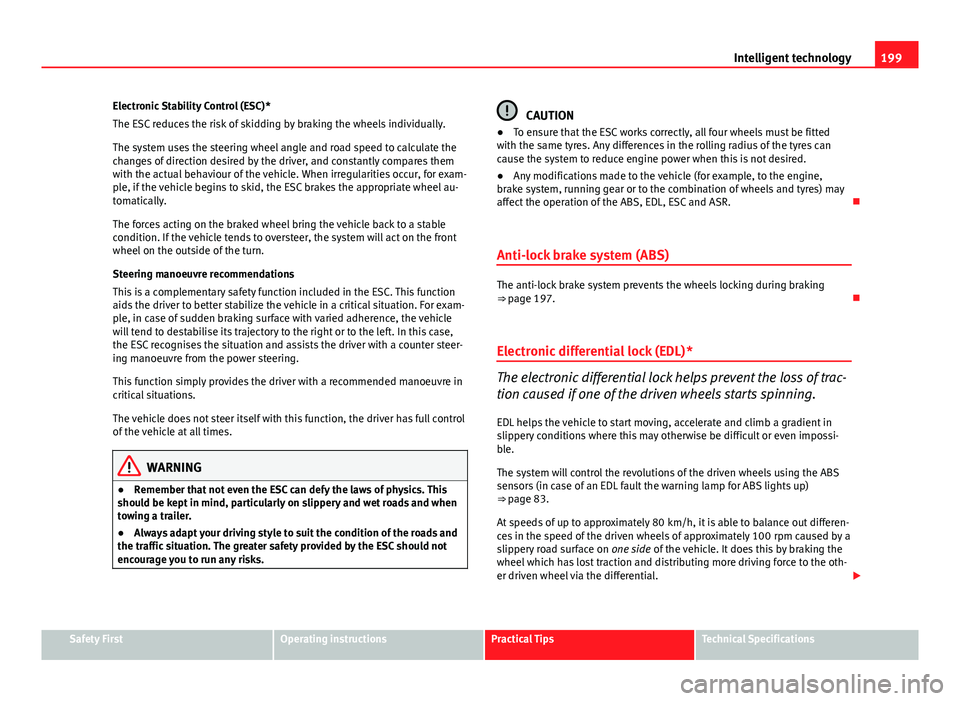
199
Intelligent technology
Electronic Stability Control (ESC)*
The ESC reduces the risk of skidding by braking the wheels individually.
The system uses the steering wheel angle and road speed to calculate the
changes of direction desired by the driver, and constantly compares them
with the actual behaviour of the vehicle. When irregularities occur, for exam-
ple, if the vehicle begins to skid, the ESC brakes the appropriate wheel au-
tomatically.
The forces acting on the braked wheel bring the vehicle back to a stable
condition. If the vehicle tends to oversteer, the system will act on the front
wheel on the outside of the turn.
Steering manoeuvre recommendations
This is a complementary safety function included in the ESC. This function
aids the driver to better stabilize the vehicle in a critical situation. For exam-
ple, in case of sudden braking surface with varied adherence, the vehicle
will tend to destabilise its trajectory to the right or to the left. In this case,
the ESC recognises the situation and assists the driver with a counter steer-
ing manoeuvre from the power steering.
This function simply provides the driver with a recommended manoeuvre in
critical situations.
The vehicle does not steer itself with this function, the driver has full control
of the vehicle at all times.
WARNING
● Remember that not even the ESC can defy the laws of physics. This
should be kept in mind, particularly on slippery and wet roads and when
towing a trailer.
● Always adapt your driving style to suit the condition of the roads and
the traffic situation. The greater safety provided by the ESC should not
encourage you to run any risks.
CAUTION
● To ensure that the ESC works correctly, all four wheels must be fitted
with the same tyres. Any differences in the rolling radius of the tyres can
cause the system to reduce engine power when this is not desired.
● Any modifications made to the vehicle (for example, to the engine,
brake system, running gear or to the combination of wheels and tyres) may
affect the operation of the ABS, EDL, ESC and ASR.
Anti-lock brake system (ABS)
The anti-lock brake system prevents the wheels locking during braking
⇒ page 197.
Electronic differential lock (EDL)*
The electronic differential lock helps prevent the loss of trac-
tion caused if one of the driven wheels starts spinning.
EDL helps the vehicle to start moving, accelerate and climb a gradient in
slippery conditions where this may otherwise be difficult or even impossi-
ble.
The system will control the revolutions of the driven wheels using the ABS
sensors (in case of an EDL fault the warning lamp for ABS lights up)
⇒ page 83.
At speeds of up to approximately 80 km/h, it is able to balance out differen-
ces in the speed of the driven wheels of approximately 100 rpm caused by a
slippery road surface on one side of the vehicle. It does this by braking the
wheel which has lost traction and distributing more driving force to the oth-
er driven wheel via the differential.
Safety FirstOperating instructionsPractical TipsTechnical Specifications
Page 256 of 321
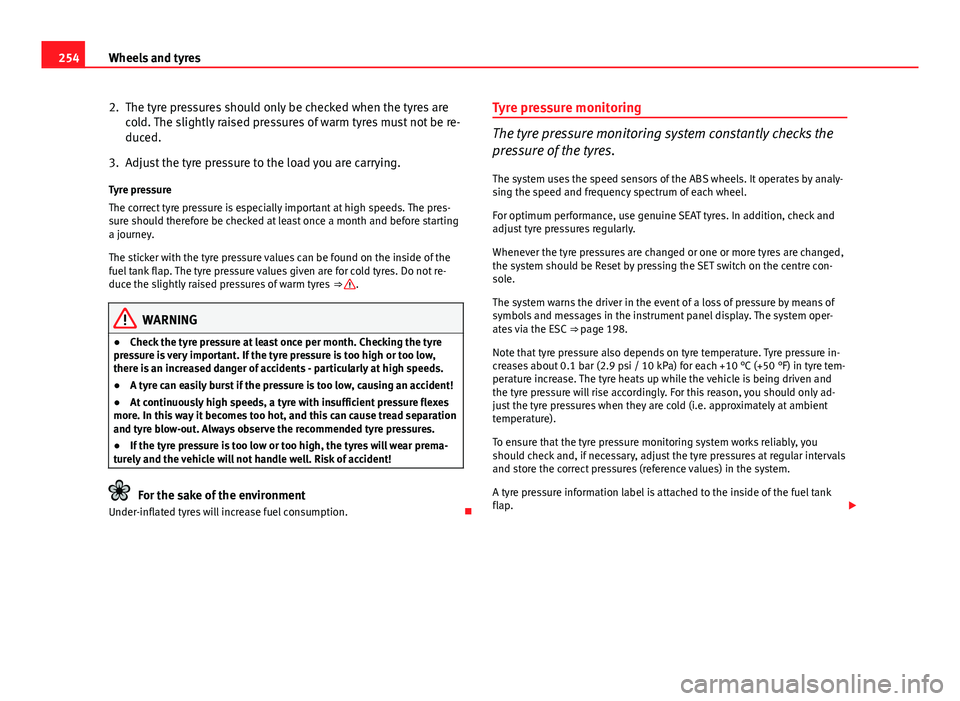
254Wheels and tyres
2. The tyre pressures should only be checked when the tyres are
cold. The slightly raised pressures of warm tyres must not be re-
duced.
3. Adjust the tyre pressure to the load you are carrying.
Tyre pressure
The correct tyre pressure is especially important at high speeds. The pres-
sure should therefore be checked at least once a month and before starting
a journey.
The sticker with the tyre pressure values can be found on the inside of the
fuel tank flap. The tyre pressure values given are for cold tyres. Do not re-
duce the slightly raised pressures of warm tyres ⇒
.
WARNING
● Check the tyre pressure at least once per month. Checking the tyre
pressure is very important. If the tyre pressure is too high or too low,
there is an increased danger of accidents - particularly at high speeds.
● A tyre can easily burst if the pressure is too low, causing an accident!
● At continuously high speeds, a tyre with insufficient pressure flexes
more. In this way it becomes too hot, and this can cause tread separation
and tyre blow-out. Always observe the recommended tyre pressures.
● If the tyre pressure is too low or too high, the tyres will wear prema-
turely and the vehicle will not handle well. Risk of accident!
For the sake of the environment
Under-inflated tyres will increase fuel consumption. Tyre pressure monitoring
The tyre pressure monitoring system constantly checks the
pressure of the tyres.
The system uses the speed sensors of the ABS wheels. It operates by analy-
sing the speed and frequency spectrum of each wheel.
For optimum performance, use genuine SEAT tyres. In addition, check and
adjust tyre pressures regularly.
Whenever the tyre pressures are changed or one or more tyres are changed,
the system should be Reset by pressing the SET switch on the centre con-
sole.
The system warns the driver in the event of a loss of pressure by means of
symbols and messages in the instrument panel display. The system oper-
ates via the ESC ⇒ page 198.
Note that tyre pressure also depends on tyre temperature. Tyre pressure in-
creases about 0.1 bar (2.9 psi / 10 kPa) for each +10 °C (+50 °F) in tyre tem-
perature increase. The tyre heats up while the vehicle is being driven and
the tyre pressure will rise accordingly. For this reason, you should only ad-
just the tyre pressures when they are cold (i.e. approximately at ambient
temperature).
To ensure that the tyre pressure monitoring system works reliably, you
should check and, if necessary, adjust the tyre pressures at regular intervals
and store the correct pressures (reference values) in the system.
A tyre pressure information label is attached to the inside of the fuel tank
flap.
Page 316 of 321
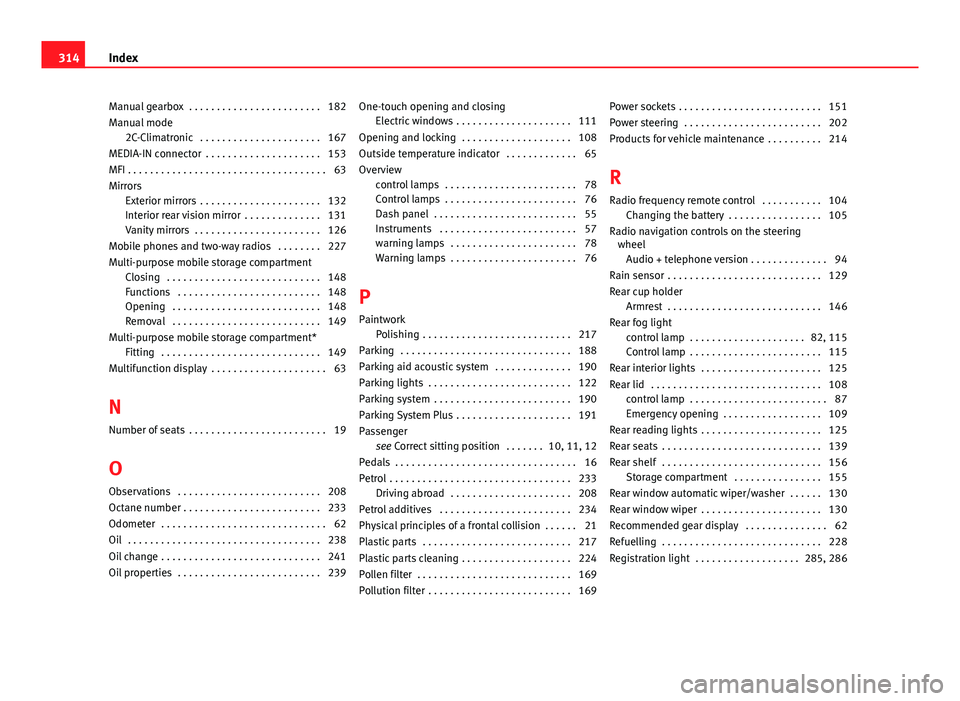
Manual gearbox . . . . . . . . . . . . . . . . . . . . . . . . 182
Manual mode2C-Climatronic . . . . . . . . . . . . . . . . . . . . . . 167
MEDIA-IN connector . . . . . . . . . . . . . . . . . . . . . 153
MFI . . . . . . . . . . . . . . . . . . . . . . . . . . . . . . . . . . . . 63
Mirrors Exterior mirrors . . . . . . . . . . . . . . . . . . . . . . 132
Interior rear vision mirror . . . . . . . . . . . . . . 131
Vanity mirrors . . . . . . . . . . . . . . . . . . . . . . . 126
Mobile phones and two-way radios . . . . . . . . 227
Multi-purpose mobile storage compartment Closing . . . . . . . . . . . . . . . . . . . . . . . . . . . . 148
Functions . . . . . . . . . . . . . . . . . . . . . . . . . . 148
Opening . . . . . . . . . . . . . . . . . . . . . . . . . . . 148
Removal . . . . . . . . . . . . . . . . . . . . . . . . . . . 149
Multi-purpose mobile storage compartment* Fitting . . . . . . . . . . . . . . . . . . . . . . . . . . . . . 149
Multifunction display . . . . . . . . . . . . . . . . . . . . . 63
N
Number of seats . . . . . . . . . . . . . . . . . . . . . . . . . 19
O
Observations . . . . . . . . . . . . . . . . . . . . . . . . . . 208
Octane number . . . . . . . . . . . . . . . . . . . . . . . . . 233
Odometer . . . . . . . . . . . . . . . . . . . . . . . . . . . . . . 62
Oil . . . . . . . . . . . . . . . . . . . . . . . . . . . . . . . . . . . 238
Oil change . . . . . . . . . . . . . . . . . . . . . . . . . . . . . 241
Oil properties . . . . . . . . . . . . . . . . . . . . . . . . . . 239 One-touch opening and closing
Electric windows . . . . . . . . . . . . . . . . . . . . . 111
Opening and locking . . . . . . . . . . . . . . . . . . . . 108
Outside temperature indicator . . . . . . . . . . . . . 65
Overview control lamps . . . . . . . . . . . . . . . . . . . . . . . . 78
Control lamps . . . . . . . . . . . . . . . . . . . . . . . . 76
Dash panel . . . . . . . . . . . . . . . . . . . . . . . . . . 55
Instruments . . . . . . . . . . . . . . . . . . . . . . . . . 57
warning lamps . . . . . . . . . . . . . . . . . . . . . . . 78
Warning lamps . . . . . . . . . . . . . . . . . . . . . . . 76
P Paintwork Polishing . . . . . . . . . . . . . . . . . . . . . . . . . . . 217
Parking . . . . . . . . . . . . . . . . . . . . . . . . . . . . . . . 188
Parking aid acoustic system . . . . . . . . . . . . . . 190
Parking lights . . . . . . . . . . . . . . . . . . . . . . . . . . 122
Parking system . . . . . . . . . . . . . . . . . . . . . . . . . 190
Parking System Plus . . . . . . . . . . . . . . . . . . . . . 191
Passenger see Correct sitting position . . . . . . . 10, 11, 12
Pedals . . . . . . . . . . . . . . . . . . . . . . . . . . . . . . . . . 16
Petrol . . . . . . . . . . . . . . . . . . . . . . . . . . . . . . . . . 233 Driving abroad . . . . . . . . . . . . . . . . . . . . . . 208
Petrol additives . . . . . . . . . . . . . . . . . . . . . . . . 234
Physical principles of a frontal collision . . . . . . 21
Plastic parts . . . . . . . . . . . . . . . . . . . . . . . . . . . 217
Plastic parts cleaning . . . . . . . . . . . . . . . . . . . . 224
Pollen filter . . . . . . . . . . . . . . . . . . . . . . . . . . . . 169
Pollution filter . . . . . . . . . . . . . . . . . . . . . . . . . . 169 Power sockets . . . . . . . . . . . . . . . . . . . . . . . . . . 151
Power steering . . . . . . . . . . . . . . . . . . . . . . . . . 202
Products for vehicle maintenance . . . . . . . . . . 214
R Radio frequency remote control . . . . . . . . . . . 104 Changing the battery . . . . . . . . . . . . . . . . . 105
Radio navigation controls on the steering wheel
Audio + telephone version . . . . . . . . . . . . . . 94
Rain sensor . . . . . . . . . . . . . . . . . . . . . . . . . . . . 129
Rear cup holder Armrest . . . . . . . . . . . . . . . . . . . . . . . . . . . . 146
Rear fog light control lamp . . . . . . . . . . . . . . . . . . . . . 82, 115
Control lamp . . . . . . . . . . . . . . . . . . . . . . . . 115
Rear interior lights . . . . . . . . . . . . . . . . . . . . . . 125
Rear lid . . . . . . . . . . . . . . . . . . . . . . . . . . . . . . . 108 control lamp . . . . . . . . . . . . . . . . . . . . . . . . . 87
Emergency opening . . . . . . . . . . . . . . . . . . 109
Rear reading lights . . . . . . . . . . . . . . . . . . . . . . 125
Rear seats . . . . . . . . . . . . . . . . . . . . . . . . . . . . . 139
Rear shelf . . . . . . . . . . . . . . . . . . . . . . . . . . . . . 156 Storage compartment . . . . . . . . . . . . . . . . 155
Rear window automatic wiper/washer . . . . . . 130
Rear window wiper . . . . . . . . . . . . . . . . . . . . . . 130
Recommended gear display . . . . . . . . . . . . . . . 62
Refuelling . . . . . . . . . . . . . . . . . . . . . . . . . . . . . 228
Registration light . . . . . . . . . . . . . . . . . . . 285, 286
314 Index
Page 319 of 321
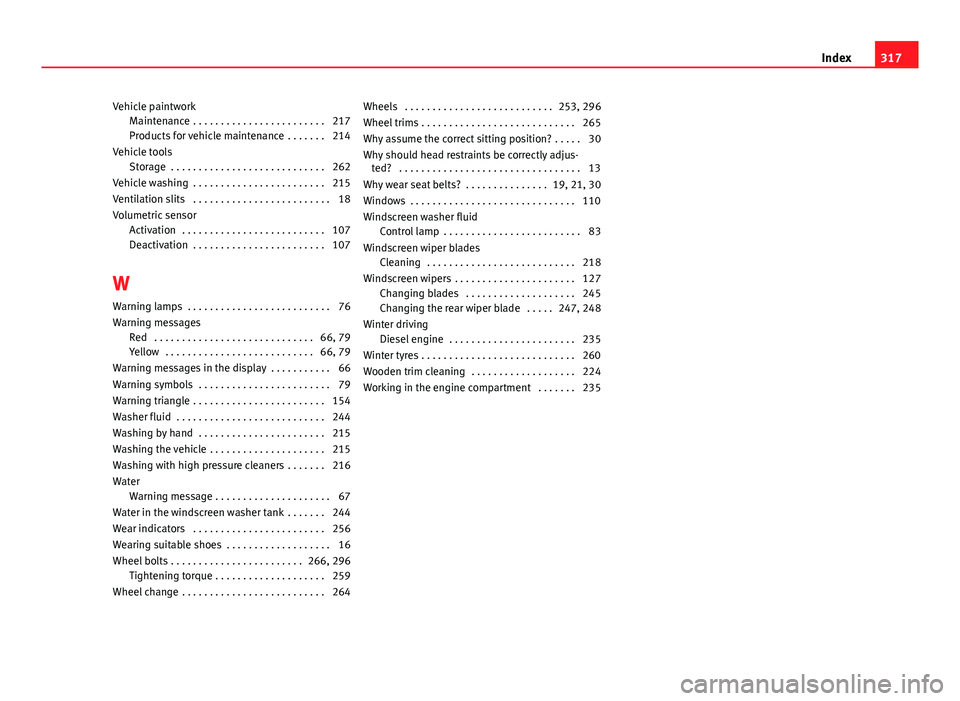
Vehicle paintworkMaintenance . . . . . . . . . . . . . . . . . . . . . . . . 217
Products for vehicle maintenance . . . . . . . 214
Vehicle tools Storage . . . . . . . . . . . . . . . . . . . . . . . . . . . . 262
Vehicle washing . . . . . . . . . . . . . . . . . . . . . . . . 215
Ventilation slits . . . . . . . . . . . . . . . . . . . . . . . . . 18
Volumetric sensor Activation . . . . . . . . . . . . . . . . . . . . . . . . . . 107
Deactivation . . . . . . . . . . . . . . . . . . . . . . . . 107
W Warning lamps . . . . . . . . . . . . . . . . . . . . . . . . . . 76
Warning messages Red . . . . . . . . . . . . . . . . . . . . . . . . . . . . . 66, 79
Yellow . . . . . . . . . . . . . . . . . . . . . . . . . . . 66, 79
Warning messages in the display . . . . . . . . . . . 66
Warning symbols . . . . . . . . . . . . . . . . . . . . . . . . 79
Warning triangle . . . . . . . . . . . . . . . . . . . . . . . . 154
Washer fluid . . . . . . . . . . . . . . . . . . . . . . . . . . . 244
Washing by hand . . . . . . . . . . . . . . . . . . . . . . . 215
Washing the vehicle . . . . . . . . . . . . . . . . . . . . . 215
Washing with high pressure cleaners . . . . . . . 216
Water Warning message . . . . . . . . . . . . . . . . . . . . . 67
Water in the windscreen washer tank . . . . . . . 244
Wear indicators . . . . . . . . . . . . . . . . . . . . . . . . 256
Wearing suitable shoes . . . . . . . . . . . . . . . . . . . 16
Wheel bolts . . . . . . . . . . . . . . . . . . . . . . . . 266, 296 Tightening torque . . . . . . . . . . . . . . . . . . . . 259
Wheel change . . . . . . . . . . . . . . . . . . . . . . . . . . 264 Wheels . . . . . . . . . . . . . . . . . . . . . . . . . . . 253, 296
Wheel trims . . . . . . . . . . . . . . . . . . . . . . . . . . . . 265
Why assume the correct sitting position? . . . . . 30
Why should head restraints be correctly adjus-
ted? . . . . . . . . . . . . . . . . . . . . . . . . . . . . . . . . . 13
Why wear seat belts? . . . . . . . . . . . . . . . 19, 21, 30
Windows . . . . . . . . . . . . . . . . . . . . . . . . . . . . . . 110
Windscreen washer fluid Control lamp . . . . . . . . . . . . . . . . . . . . . . . . . 83
Windscreen wiper blades Cleaning . . . . . . . . . . . . . . . . . . . . . . . . . . . 218
Windscreen wipers . . . . . . . . . . . . . . . . . . . . . . 127 Changing blades . . . . . . . . . . . . . . . . . . . . 245
Changing the rear wiper blade . . . . . 247, 248
Winter driving Diesel engine . . . . . . . . . . . . . . . . . . . . . . . 235
Winter tyres . . . . . . . . . . . . . . . . . . . . . . . . . . . . 260
Wooden trim cleaning . . . . . . . . . . . . . . . . . . . 224
Working in the engine compartment . . . . . . . 235
317
Index